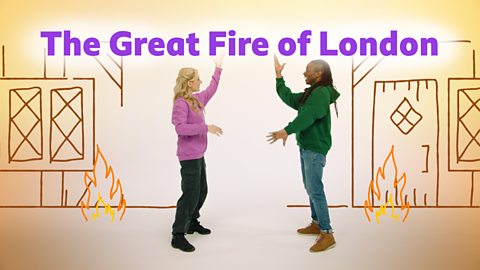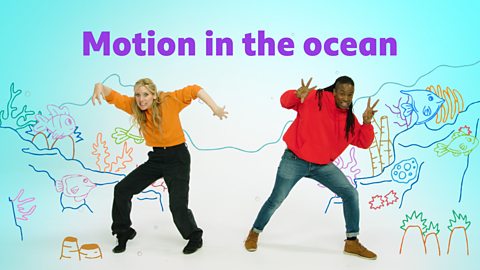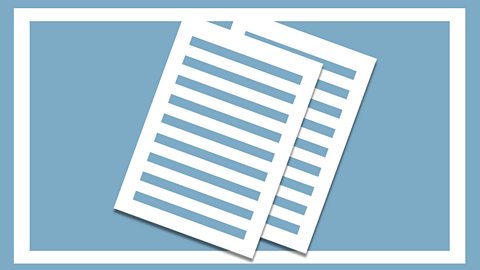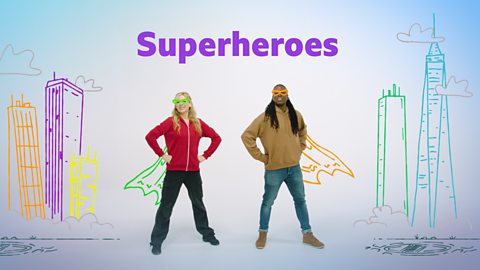Join Naomi Wilkinson and Nigel Clarke for four Key Stage 1 dance sessions.
The topics are 1: The Great Fire of London; 2: Space adventure; 3: Motion in the ocean; 4: Superheroes.
The videos
The Great Fire of London. collection
Travel back in time with Naomi and Nigel to tell the story of The Great Fire of London through dance.

Space adventure. collection
Join Naomi and Nigel for a KS1 dance adventure in outer space.

Motion in the ocean. collection
Join Naomi and Nigel for an underwater dance adventure on a coral reef.


Let's Move with Naomi and Nigel!
Introduction
The Let’s Move with Naomi and Nigel! series of videos for KS1 children are designed to help teachers deliver dance lessons as part of their PE offering.
Each film is around 20 minutes long but can be used by teachers as the basis of a lesson as much as 1 hour long, depending on how teachers choose to mediate the video. It can be adapted and utilised according to their needs.
Each film is presented by Naomi Wilkinson and Nigel Clarke - familiar faces from C91»»±¨. The films combine sections in which the children will follow the instructions given by Naomi and Nigel, and sections in which the children move independently, using the music as a stimulus.
Each dance session begins with a warm-up during which the children join in with Naomi and Nigel, copying their movements.
This is followed by a series of progressive sections featuring clear instructions, and examples of dance movements for the children to try and build on during passages of music. Children are encouraged to use their imaginations while experimenting with movement.
The videos end with a cool down for the whole class to enjoy together, to regain a sense of calm, ready for the next part of their school day.
How to use the videos
Before using a session make sure you familiarise yourself with the content by reading the Teacher Notes which are available in the Resources section of each page or below. We also recommend that you watch the video beforehand to become familiar with any ‘pause points’ and to assess how best to mediate the playback.
Let’s Move! needs plenty of space. The hall or a cleared and swept classroom or similar large space is ideal. You will also need a white board (or suitable alternative device) to play the video.
Make sure the children dance in gym shoes or bare feet. Bare feet give a good sense of contact with the floor, if your floor is safe. The children should be in PE kit to allow easy movement and to ensure that they do not become too hot.
During playback of the video there are two key things to be aware of:
- Each of the sections in which the children movement independently to the music feature a countdown clock, so that everyone can be ready for the end of the musical track.
This is an opportunity for teachers to be ready to reinforce the instruction given in the video that it is time to stop moving and return attention to the video for the next sequence. - The countdown clock is followed by an instruction from Naomi or Nigel to stop moving. At these points you will also see a ‘pause’ icon appear on screen. These indicate appropriate points for the teacher to pause the video should they want to check that the children understand the instructions, prepare them for the upcoming section, or explore more ideas with their class. You will find timings for the pause points in the lesson framework below.
Teaching points
Some tips to help you get the best out of the dance sessions:
- always encourage careful listening
- reinforce the importance of safety - eg awareness of others to avoid collisions, spacing, sensible landings (with the whole foot, flexing as it comes down and knees bending)
- help the children to observe each other’s movement in a positive light and to learn from their observations
- give the children a sense of your own enthusiasm

Resources
Print / download the Teacher Notes for the session on The Great Fire of London

Download / print the Teacher Notes for the session on Space adventure

Download / print the Teacher Notes for the session on Motion in the ocean

Download / print the Teacher Notes for the session on Superheroes


Curriculum relevance
Let's Move - with Naomi and Nigel! addresses the following learning objectives from the curriculum guidance of the four UK nations:
England
National Curriculum Programmes of Study for Physical Education in Key Stage One:
Pupils should develop fundamental movement skills, become increasingly competent and confident and access a broad range of opportunities to extend their agility, balance and coordination, individually and with others.
They should be able to engage in competitive (both against self and against others) and co-operative physical activities, in a range of increasingly challenging situations.
Pupils should be taught to:
Master basic movements including running, jumping, throwing and catching, as well as developing balance, agility and co-ordination, and begin to apply these in a range of activities.
Perform dances using simple movement patterns.
Scotland
Curriculum for Excellence - Physical Education as part of the wider Health and Wellbeing section. Outcomes:
I am learning to move my body well, exploring how to manage and control it and finding out how to use and share space.
I am discovering ways that I can link actions and skills to create movement patterns and sequences. This has motivated me to practice and improve my skills to develop control and flow.
I am developing my movement skills through practice and energetic play.
I am developing skills and techniques and improving my level of performance and fitness.
I am aware of my own and others’ needs and feelings especially when taking turns and sharing resources. I recognise the need to follow rules.
I can follow and understand rules and procedures, developing my ability to achieve personal goals. I recognise and can adopt different roles in a range of practical activities.
By exploring and observing movement, I can describe what I have learned about it.
I can recognise progress and achievement by discussing my thoughts and feelings and giving and accepting feedback.
Northern Ireland
The minimum content for Physical Education at KS1 is set out below:
Teachers should provide opportunities for pupils to develop knowledge, understanding and skills in:
Dance
Pupils should be enabled to: use different parts of the body to explore personal and general space and to move using simple actions; listen to, and move in response to, different stimuli and accompaniments; move in a controlled manner, at different speeds and in different directions, using different levels in space, (high, low), and different strengths (heavy, light); perform simple steps and movements to given rhythms and musical phrases; create, practice, remember and perform simple movement sequences; develop their movements progressively individually and in pairs.
Wales
Foundation Phase Framework. Physical Skills:
Personal
• develop coordination • develop gross motor skills • develop fine manipulative skills • develop confidence • control body movements • develop muscle tone, appropriate tension and balance • develop sensory awareness • use a range of small and large equipment and stimuli • link the basic actions in sequence and gradually improve their control and use of different shapes, levels and direction of travel.
Adventurous and Physical Play
• develop an understanding of how their bodies move • be able to move safely with increasing control and coordination • become proficient at the basic actions of travelling, including stepping, jumping and landing, transferring weight from feet to hands, balancing, rolling, turning, climbing and swinging, both on the floor and when using a range of equipment and apparatus • link the basic actions in sequence and gradually improve their control and use of different shapes, levels and direction of travel • understand, appreciate and enjoy the differences between running, walking, skipping, jumping, climbing and hopping • become knowledgeable about spatial awareness and relationships such as behind, underneath, below, over, under and on top of.
Health, fitness and safety
• recognise the effects exercise has on their bodies as they move • describe what happens to their breathing and how they look and feel after exercise • begin to understand that regular exercise improves health and fitness and that it helps body parts to work well • become aware of dangers and safety issues in their environment.

